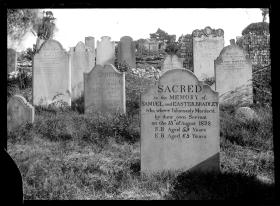Cemetery site study
Students complete a digital site study using digitised collection materials from the State Library’s collection that relate to the Devonshire Street Cemetery.
Key inquiry question #1
What can we find out about the past from archaeological and written sources?
Learning intention
Students are learning to:
- use sources related to a particular historical site to understand change and continuity in the needs of society in that area.
Success criteria
Students will be successful when they can:
- interpret sources and extract relevant information
- form opinions or make judgements about history
- empathise with people living in different times in history.
Student Activities
Headstones as historical sources
Students use headstones as primary sources to tell us about a person’s life and discuss ethical issues surrounding the preservation of headstones and cemeteries.

Digital Site Study
Students use digitally available primary and secondary sources to piece together the history of the Devonshire Street Cemetery.

A visit to your local cemetery (optional)
Students visit a local cemetery and use the headstones to find out more about the history of their local area and use this information to develop an online exhibition for their local museum, cultural centre or community ‘hub’.

Background information for teachers and students
INQUIRY QUESTION: What can cemeteries and headstones tell us about people in the past?
Written in stone
History is not just written in books. You can find out about people in the past from many different places. Head stones in cemeteries can tell us about the lives of people who lived in the past. These inscriptions don’t just tell us about famous people of their time. They also tell us about ordinary people or forgotten people.
Cemeteries can tell us who they were and how they lived. An inscription will tell us their name, their date of birth and the date they died. They often tell us about their family members. We can also find out about their religious beliefs. We should always remember that a grave is the place where the remains of a person are buried. They were once alive and were important to their family, friends and admirers.
Cemeteries and graves are important places for history. We should respect them and take care of them for the future. Some cemeteries are tourist attractions, where people go to visit the graves of great and famous people.
Digital Site Study: The Devonshire Street Cemetery
The major cemetery for 19th century Sydney, the Devonshire Street Cemetery was divided by walls into seven sections denoting religious denominations. The oldest was the Church of England section, then Roman Catholic, Presbyterian, Congregationalist, Wesleyan, Quaker and Jewish sections.
Consecrated in 1820, the cemetery filled quickly over the following decades. It was officially closed in 1867, but family vaults continued to accept new burials. By the end of the 19th century, the entire ground was overgrown and uncared for; burials had been made within every square inch, even under paths. Rubbish was often dumped from neighbouring terraces, and at night it was a dangerous, insalubrious place.
In January 1901 the State government announced its intention to clear the cemetery to make way for Central Station. It is estimated that over 30,000 bodies had to be removed. Descendants were given two months’ notice to decide where their forebears’ remains would be reinterred. Those not claimed would be transferred to Bunnerong cemetery, an extension of Botany cemetery.
Before the graves were exhumed, two dedicated locals from nearby Albion Street, Surry Hills, set about documenting the cemetery. Married couple Arthur and Josephine Ethel Foster were standing next to the headstone of ex-convict and successful businesswoman Mary Reibey when they decided to photograph and copy the inscriptions.
Mrs Foster photographed the headstones as Mr Foster cleared away the undergrowth and inked the text carved into the stone to ensure the words were clear. He also copied the inscriptions into notebooks. While the couple primarily documented the Church of England section, their record is extraordinary — it allows us to look back to 19th century Sydney and read the tragic accounts of short lives and misfortunate deaths.
NSW Syllabus for the Australian Curriculum History K–10
- HT4–5 identifies the meaning, purpose and context of historical sources
- HT4–6 uses evidence from sources to support historical narratives and explanations
- HT4–8 locates, selects and organises information from sources to develop an historical inquiry
- HT4–10 selects and uses appropriate oral, written, visual and digital forms to communicate about the past
Students:
- outline the main features of history and archaeology
- outline the role of historians and archaeologists
- list a range of sources used by archaeologists and historians in historical investigations
Perspectives and interpretations
- identify and describe different perspectives of participants in a particular historical context (ACHHS212, ACHHS155)
Empathetic understanding
- interpret history within the context of the actions, attitudes and motives of people in the context of the past (ACHHS212, ACHHS155)
Research
- ask a range of questions about the past to inform an historical inquiry (ACHHS207, ACHHS150)
- use a range of communication forms and technologies
Explanation and communication
- develop historical texts, particularly explanations and historical arguments that use evidence from a range of sources (ACHHS213, ACHHS156)
- select and use a range of communication forms (oral, graphic, written and digital) to communicate effectively about the past (ACHHS214, ACHHS157)
Continuity and change: some aspects of a society, event or development change over time and others remain the same.
Empathetic understanding: the ability to understand another’s point of view, way of life and decisions made in a different period of time or society.
- Critical and creative thinking
- Ethical understanding
- Information and communication technology capability
- Civics and citizenship
The range of sources that can be used in an historical investigation, including archaeological and written sources (ACDSEH029)